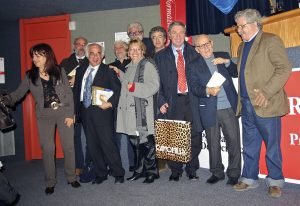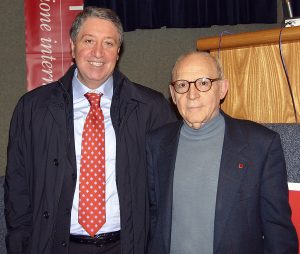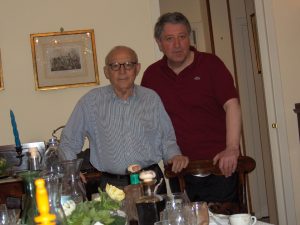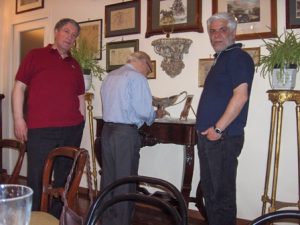Language and Power in Vincenzo Consolo’s Sicily.
(Harvard, ACLA, 26-29 March, 2009)
In 1963, Vincenzo Consolo, then a thirty year old Sicilian lawyer and notary trainee, publishes April’s Wound, his first novel. The partly autobiographical story depicts the young first person narrator’s coming of age during his last year spent in a Catholic secondary school in his anonymous home village on the North-Eastern coast of Sicily. April’s Wound is Consolo’s timely contribution to Italian Neorealism in literary fiction. It is as much the first instance of his innovative literary technique of evoking historical and political moments through a stylistic mosaic of different languages and styles. Such a technique will later become his literary trademark. The pivot of April’s Wound, the “wound” the title refers to, is the defeat inflicted to the Christian Democrats and their historic post war leader De Gasperi in the regional ballot held in Sicily April1947. The assassination, one week later, by Salvatore Giuliano’s mafia mob, of children and workers during Labor Day celebrations, may be read as the first sign of how well Sicilian conservatives were going to respect the democratic process. Italy’s and specifically Sicily’s politics and society, however present in Consolo’s writings, are not my main concern, though, in this paper. Instead we will focus on what Consolo stands for today among Italian writersd, that is to say his fixation on language, his preoccupation with different kinds of language, ancient and modern, national and local, authentic and invented, on language as a tool for expressing and exerting power, and also on language as a token of violence, verbal and physical. Consolo’s first novel shares with the Neorealist movement an awareness for working class settings and characters, but more than the other novelists Consolo elaborates on language, both the novel’s and the characters’ language, its symbolism and shape. April’s Wound is but a forerunner, from this perspective, of the author’s 1976 masterpiece, The Smile of the Unknown Mariner, which sets totally new standards for the historical novel as such, not only for Italy. This short but complex fictional tour de force carries the reader to the last stages of Italy’s national unification process, Garibaldi’s landing on Sicilian soil in Marsala, May 1860, and the subsequent liberation, or annexation, as some will pretend, of Sicily. The plot focuses on the revolutionary uprising of shepherds and laborers more or less in the same area where April’s Wound is located, Consolo’s own familiar grounds. The revolt takes place a few days after Garibaldi’s landing and is violently repressed by one of his lieutenants, Bixio. Again, languages take center stage, languages unveiled by different kinds of speakers and writers, listeners and readers, preachers and intellectuals. Language, both as a subject and a tool, joins the two novels, April’s Wound and The Smile of the Unknown Mariner. April’s Wound makes clear how through liturgy and rituals in Latin and daily mass the clergy’s authority over the youngsters is well established. Harsh control is exerted on the use of the national language during recreation where local dialect is banished. In The Smile of the Unknown Mariner a hybrid form of Latin is the hermit’s natural language the moment he betrays the rebels’cause and rapes a dying maiden in church. Dialect and so called “natural” language is good enough to accompany the rebels’ suffering once in prison, while the oppressor’s language establishes supremacy both over the future, through law, and over the past, through historiography.
It becomes clear with respect to Consolo’s novels that a very close relationship can be established with some important issues of cultural theory concerning language, power and violence. Except for Max Weber’s and Antonio Gramsci’s seminal writings on the subject, April’s Wound, 1963, may be considered a fictional forerunner of Bourdieu, Habermas, Said, some of the French new cultural historians and even Foucault. Let me just quote Weber’s phrase inaugurating the external, sociological, non-saussurian, view of language: “The language, and that means the literature based upon it, is the first and for the time being the only cultural value at all accessible to the masses who ascend toward participation in culture.” (From Max Weber, p.178: Google). The most influential and, on this topic, most explicit thinker, Pierre Bourdieu, did not publish “Ce que parler veut dire”, What it means to speak, until 1982. Its title polemically echoes Austin’s influential findings on the performative property of language as exposed in How to do things with words?, 1955. Homi Bhabha’s 2006 paper, delivered at a Berlin conference on Violence Through Language, almost literally echoes Consolo’s title: Words and Wounds. The parallel development, both in fiction and in theory, of these crucial theoretical issues asks for a closer look of what April’s Wound reveals about them.
Daily mass in Latin is as much part of the school’s routine as classes and games. More than classes do, celebrations in the chapel establish the institutionalized choreography of power, the collective confirmation of scholastic hierarchy, symbol for hierarchy tout court and as such. In a certain sense one could say two rituals are simultaneously taking place each time mass is celebrated, a religious one and another with more mundane aspirations. In one trans-substantiation of wine and bread is liturgically performed, in the other the ruling body of clergy, altar boys, singers and pupils, well behaving and not, is structurally substantiated. Social and political tensions between right and left wing families, between former fascist and anti-fascist groups, or, for that matter, between mafiosi clans and regular folks, are supremely regulated within the impressive dramatical framework of solemn religious celebrations. Stage directions – who will sing? What will be sung? who will be the altar boys? Who will do the pedaling for the organ? – are of course given in Italian, but the language on stage is invariably Latin, supported by the cranky but not less imposing notes of the wind organ. Daily repetition of prayers and songs acoustically and visually underline the well established order of things in the world. The encense burner is rhythmically shaken three times in honor of each of the three major martyr saints of Southern Italy: “look here Alfio, Cirino and Filadelfio, wah ACF, poor ACF” (6). Not one gesture evades the rules of the religious ritual disposing a second layer of authority on top of the scholastic hierarchy, both firmly hold by the rector and his fellow priests. The two layers of authority are indistinctly mixed, transparent to each other. Does not this setting exactly correspond to what Bourdieu refers to, with respect to the authority seized by different sorts of religion, as the “rigorous observance of the code of the uniform liturgy, which governs the sacramental gestures and words”(115)? Is not Consolo’s representation exactly that of the “priest (as) holder of a monopoly in the manipulation of the goods of salvation”(ib.)? Youngsters jokingly create burlesque or nonsensical parodies of prayers, mixing Latin with Italian. However, publicly and in the open, only official versions resound, and punishment and mockery awaits those who do not respect the unwritten rules, those who dare to stumble with the incense burner and spoil the burning coal on the chapel floor. Bourdieu says: “The language of authority never governs without the collaboration of those it governs” (113). Nowhere is this interplay of authority, language policy, complicity of subjects and violence displayed as nicely as in the “accipe” setup. What is “accipe”? During recreation the only language pupils may use for games and conversation is Italian. Every occurrence of the local language, the so called “natural speak”, the Sicilian dialect of the North-East coast, is severely forbidden. And to enforce the language policy a method of punishment is put in place operated by the pupils themselves. One of them is on watch, a token in hand, and as soon as natural forbidden sounds are heard the token is handed over to the offender with the phrase: “accipe”, Latin for “take this”. He is then exposed to public mockery until another language abuse is detected and the accipe-token proceeds to the next step of its regulatory operations, its linguistically cleansing the juvenile crowd. The accipe punishment formally adopts the scheme of a whole series of well known children’s plays based on hiding and discovering tokens passed on between the players. The accipe-scheme actually perverts these plays in transforming the school playground into something much closer to a prison yard. Recreation is turned into discipline and control. Rule enforcement is entrusted to those subjects to whom the rule applies in an uninterrupted cycle of traps and punishments. Other, even more daunting episodes of twentieth century history may come to mind where guilt was charged upon the victims’ shoulders, the joyful context of playing children notwithstanding. Bourdieu refers interestingly to the ancient Greek practice, among the gerontes assembled in the agora, as illustrated in the Iliad, of grabbing the skeptron, the staff entitling the holder of it to speak publicly. Through the gerontes, as symbolized by the skeptron, the institutions themselves speak. They confer authority, both authority to speak and authority tout court. Deceptively innocuous and benign, the accipe scheme is a perversion of the skeptron rule. The accipe is not grabbed by someone to speak, it is imposed on you to silence you, and together with you all those trapped in the cycle. The skeptron has become a whip .Dialect or “natural speak” is what eludes authority, what establishes itself competitively outside the extended concelebration of strictly regulated liturgy, geometrical waving of the incense burner, Latin prayers and songs. That is why dialect is unwelcome. Only if totally inoffensive, completely miniaturized, limited to a handful of speakers and near to extinction, confined to two or three mountain villages, a particular dialect may be tolerated. This is the case of Consolo’s main character in April’s Wound. Carefully the novel elaborates its multilayered language design. Latin is on top as the language of authority and power, exhibited on special occasions, closely linked to the sphere of the Almighty and his heralds. Italian is the newcomer, the liberator-invader, imported on Sicilian soil from Turin by the well organized Salesiani di Don Bosco. Italian is the language of the new political order, reaching finally, after the disorders of WWII, the outskirts of the Nation, Sicily that is to say. Sicilian, language or dialect, depending on criteria, has its own lexicon, grammar and phonetics. It descends from the language spoken at Frederic II’s court and its glorious largely uninterrupted poetic tradition. Sicilian is the enemy the accipe strategy confronts head on. Consolo’s main character adds a fourth linguistic layer. He is what the other Sicilians call a “zanglé”. The etymology ─ “anglais” (English) ─ is confusing. What these very few remaining “zanglé” speak is not English, but a modern version of “anglo-norman”, close to French. Only a few remote mountain villages are left where this language is spoken. Those villagers, like Consolo’s main character and his family, who migrated to the coastal cities of Sicily, only keep a tiny accent the origin of which Italians attribute, grossly, to the North, because of its likeness to French. Where are the “zanglés” positioned in Consolo’s system of languages? They are an object of curiosity, at most of good-tempered mockery. In fact, while noticing the boy’s funny accent and asking him where he comes from, the bishop smiles. They are the exception, accepted while not threatening. No accipe operation here to root out an oddity. Language planning is but one of the support structures of the conservative-catholic wing as depicted in April’s Wound.
Languages, language use and the relationship with power and indeed violence come to the forefront in The Smile of the Unknown Mariner. Whereas the accipe-token is after all just a token, language as a “loaded weapon”, to use Dwight Bolinger’s effective metaphor, does clearly come into focus in Consolo’s 1976 novel. The main event here is a popular uprising against oppressive landlords that took place in the same mountainous area we know from April’s Wound at the time of Garibaldi’s landing, “zanglé” territory in other words. Many landowners are killed, often brutally, before the rebels are captured, brought to trial under the new Italian judiciary and convicted. The Smile of the Unknown Mariner is a new kind of historical novel and its novelty has to do with language. It ignores the homogeneous narrator’s discourse to capture characters and events. Instead a multiplicity of narrative voices can be heard corresponding to the main characters, each provided with his proper language. It is as though a more complete corporeity and materiality, imbedded in the single character’s language use, or through the language representing him, highlights their actions, gestures or events. Elite or popular language, emotionally excited or intellectually controlled language, dialects or formal speech, are mobilized as integral parts of the narrative apparatus. Two are, linguistically, the most elaborate chapters. In one, The Smile of the Unknown Mariner’s third chapter, Nunzio the hermit, outcast and serial rapist, discovers the preparations for the armed popular revolt, goes to town and alarms the well to do landowners and local gentry that trouble is coming. Father Nunzio is evil incarnate. He kills and then sexually abuses the dead body of a young maiden, in an isolated church, aptly called “Calvario”, where he had sought refuge for the night. The whole chapter is written in the manner of stream of consciousness where Latin quotes alternate with Nunzio’s copro-lalic and libidinous language. The sexual violence perpetrated on the only then deceased body is reported in a anti-psalm-like poetic language where Latin, Sicilian dialect and italian are mixed. The hermit-chapter, entitled “Sacred Dead”, illustrates how biblical and indeed sacred language can be perverted to accompany and almost excuse the most horrendous kind of violence. There would be good reasons to consider the Nunzio chapter as one long articulated allegory for evil as such, presented in every language-related variant available to the author’s linguistic and rhetorical skills. A sign for this can be the fact that Consolo made Nunzio an epileptic, suffering at the end what a now outdated medical terminology once called an attack of Grand Mal, in other words Big Evil.
The second of the two, linguistically, most elaborated chapters is also the novel’s finale. It depicts the rebels in their underground prison, artificial excavation spiraling its way downward. Again and more than ever in Consolo, language is the exclusive means to render the prisoners’ despair and outcry. What we read as written on the walls is of course Consolo’s language, the best reconstruction possible of what their messages would have been. The graffiti are, artificially and artfully, composed in a composite language where elements of Sicilian dialect show up next to words or sentences in the particular anglo-norman variant we know from April’s Wound. No Latin or Italian any more. Not much grammar or formal arrangement structures these twenty-two “scritte”. They mostly tell stories of injustice and revenge, the subsequent imprisonment being the reason why they are where they are. These are tales of a century before the “accipe” remedy was invented. These people were not even allowed to speak, no skeptron at all was handed over to them. The very existence of their “writings” on the wall is a fictional paradox: illiterate as they were, they were never able to write anything. But this definitely is what they would have written. These writings are the closest a narrative voice can get in order to let them speak and be heard, the only way to provide them with a linguistically engineered skeptron as it were. The Smile of the Unknown Mariner’s main character, the marine biologist Mandralisca turned into an intellectual in search of social justice for his fellow men, and Consolo’s alter ego, dedicates a pages long letter in which he rationally denounces the whole body of laws and history books written only by and from the point of view of literate people, the interests of which those laws and history books most naturally and directly serve. Written by and for the privileged few, these laws and history books cannot but serve the privileges of their origins. And so The Smile of the Unknown Mariner becomes the fictional counterpart for not only that part of cultural theory where inextricable relations between language and power are illustrated, but also for a vivid current among social and cultural historians trying to resuscitate what can be called the common man.
Walter Geerts



